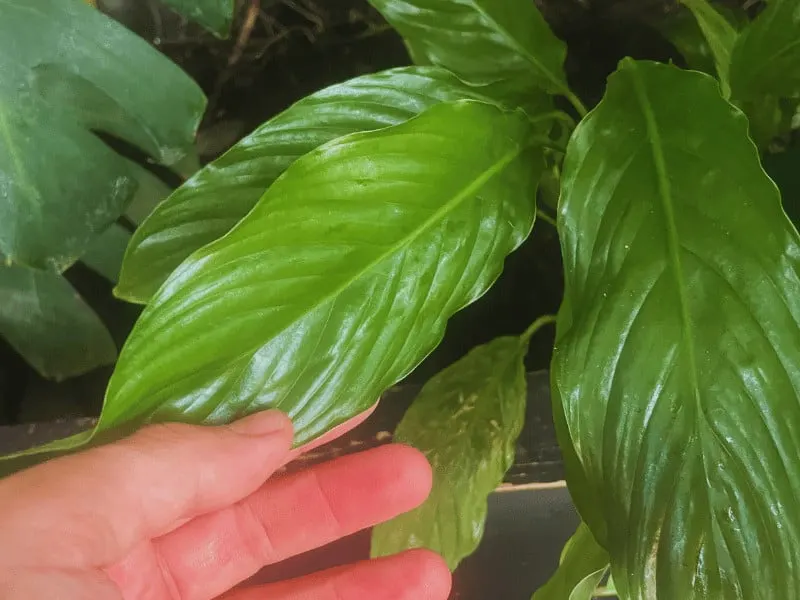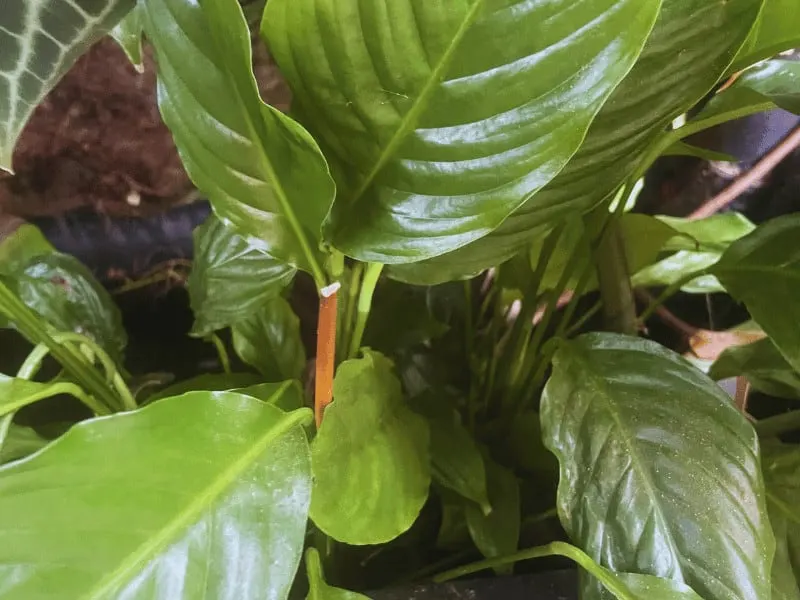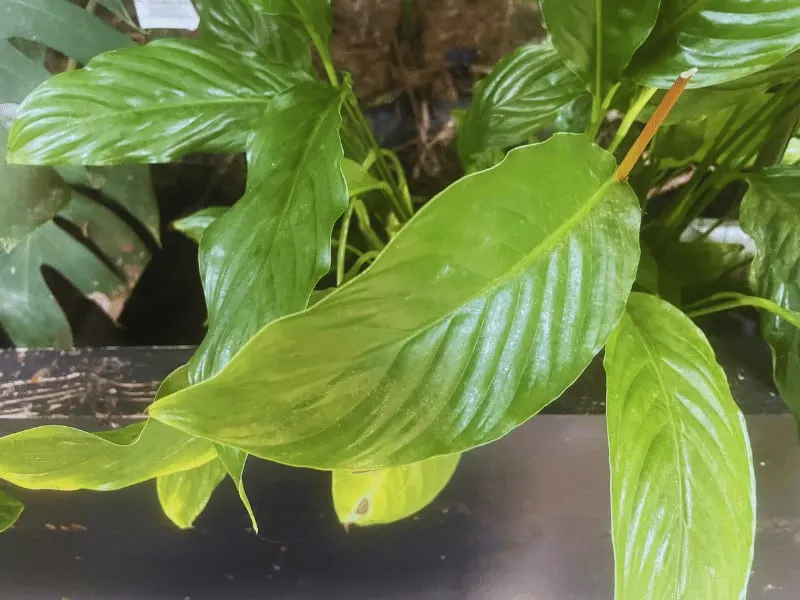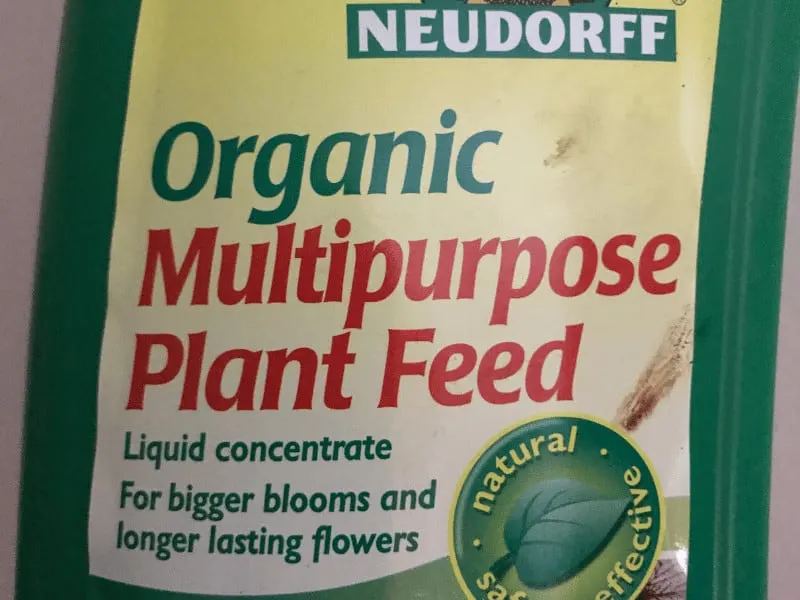Why do Peace Lilies stop flowering? The Peace Lily or Spathiphyllum (Latin name) is easy to care for. This plant has beautiful spear-like green leaves that allow its main feature, its white flower consisting of a spathe and spadix, to shine through.
Table of Contents
The Peace Lily Plant and Flowers
The Peace Lily is mainly grown for its flowers. Issues with flowering can be caused by improper care of your houseplant. The growth of blooms is dependent on optimal indoor plant conditions.
I once had a peace lily that never seemed to bloom anymore after I had bought it nicely blooming from a store. I wondered what the issues were and almost thought Peace lilies would only bloom once.
If your Peace Lily has stopped blooming, the issue can easily be fixed with a couple of steps.

Why Has My Peace Lily Stopped Flowering?
The reason why your Peace Lily may not be blooming can be due to insufficient lighting. This is the most common problem, but other things can affect the plant’s blooms. Watering, fertilizing, temperature, and being root-bound can also stop your Peace Lily from blooming. Other reasons are age and season.

7 Reasons Why Your Peace Lily Has Stopped Blooming
1. Lighting – Sufficient Light is Key

Peace lilies are robust plants and can continue to thrive in adverse conditions. However, the plant cannot bloom if the lighting conditions do not meet the requirements.
While the green leaves on a Peace Lily are attractive, they are grown for their unique flowers. To encourage the growth of flowers, ensure your plant receives enough light.
If you keep your Peace Lily in low light conditions, it will not have enough energy to bloom.
Although the plant can survive under such conditions for a while, it will produce fewer blooms as time passes.
Once fewer blooms start to appear, chances are that, over time, your Peace Lily will stop producing blooms altogether.
2. Natural Reasons – They Do not Always Flower

If kept under natural conditions, your Peace Lily will flower during the short winter days. As the days become longer, the plant starts to bloom sporadically.
The flowers on Peace Lily are tiny, insignificant blooms dotted along the spadix. The spadix is like a stick protrusion in the middle of what people think is the flower.
Once your plant is placed under proper conditions to bloom, it will produce flowers. But you should deadhead your plant regularly to promote further growth of blooms.
3. Fertilize your Peace Lily in the Growing Season

Peace Lily needs to be fed regularly with a well-balanced, water-soluble fertilizer. When the Peace Lily plant is not provided with enough fertilization, it does not have enough nutrients to produce flowers.
4. Watering – A regular schedule is important as Spathiphyllum are Dramatic
Another critical factor for Peace Lilies to bloom is watering. If your Peace Lily is not watered correctly, it will stop producing blooms.
This plant does not like to be kept in too much water. When the soil gets soggy, it will develop root rot.
However, frequent watering is necessary, and the Peace Lily can be underwatered easily, resulting in wilting. They need lots of water.
5. Repotting is necessary every 2-3 years
If your Peace Lily is not blooming and the roots have started growing out of the drainage holes, it is time to repot your plant. Not repotting your plant for several years can result in a lack of nutrients.
If you cannot spot roots from the drainage hole, see if the soil dries out faster. If it does, this is another sign that it needs to be repotted.
The cramped root will limit the nutrients available for your plant and cause your Peace Lily to stop blooming.
6. Peace lilies are sensitive to Temperatures
The Peace Lily is not highly sensitive to temperature changes. But if too much fluctuation occurs, the plant can grow fewer blooms over time.
To allow your Peace Lily to produce more blooms, you must keep it under the perfect temperature range.
7. Lifespan – A Peace Lily Does not live Forever
The lifespan of a Peace Lily is between five to ten years. Although this plant can live a little longer, it tends to produce fewer blooms as it ages.
Ways to Make Your Peace Lily Bloom
1. Fix Lighting – More light but not Direct!
Your Peace Lily will grow and bloom much faster if it is provided with bright indirect sunlight. Placing your plant close to the window will allow it to avoid direct sunlight.
The ideal places to keep your plant are the north or west-facing window sills.
The north-facing window provides the least sunlight, but the plant can have sufficient sunlight during the summer.
However, during the winter season, north-facing windows receive less sunlight, and it is best to move it to a west-facing window.
A west-facing window has lower sunlight than a south-facing window, but it provides enough sunlight for the Peace Lily plant.
But keep your plant’s foliage away from the window glass, as the temperature can rise significantly during the afternoon.
2. Provide Proper Fertilizer for your Lily
You should provide your Peace Lily with a fertilizer that has a 20-20-20 nutrient value. This will encourage your plant to grow well.
Providing a fertilizer with too much nitrogen will encourage only leaf growth and won’t allow enough blooms to grow.
Once you have provided your plant with enough fertilizer, water it and let it drain through the root system.
You should fertilize your Peace Lily every two to three weeks in the spring and summer. But during the winter season, only fertilize it after every six to eight weeks.
You could also occasionally use coffee grounds as a top dressing. This will provide your plant with extra nutrients.
3. Keep a consistent Watering Schedule
You should water your Peace Lily until you see water pouring out of the drainage holes. Once this is done, let the plant dry up completely before you water it again.
It would be best if you aimed to have slightly damp soil and ensure it is not too soggy.
If you over-water your plant, it will develop yellow leaves, or the leaves will wilt. Severe cases of over-watering can cause the roots to rot, which can be difficult to solve.
4. Repot Your Peace Lily when Needed
Repotting your plant will allow it to receive proper nutrients. First, you have to remove the plant from the pot gently.
Then replant it in a pot two to three inches larger than the old one.
Do not place your plant in a pot much larger than the previous one since it will cause waterlogging.
Ensure proper drainage holes are available at the bottom of the pot so that the water can flow out easily.
5. Maintain a General Household Temperature and Less in Winter
Keep your Peace Lily in temperatures between 60-65 degrees Fahrenheit (15-18 degrees Celsius) during winter.
During the spring season, the plant will thrive in temperatures ranging from 70-75 degrees Fahrenheit (21-24 degrees Fahrenheit).
Ideal temperatures range from 68 -85 degrees Fahrenheit in Summer (20-29 degrees Celsius).
If you provide these temperatures, your Peace Lily will produce more blooms.
FAQ
What should I do with the dead blooms on my Peace Lily?
It is best to cut off all of the dead blooms on your plant, as it will allow new ones to grow in their place.
Are the flowers on my Peace Lily toxic?
The blooms on Peace Lily are toxic to humans, dogs, and cats. Never try to consume them, and keep them away from pets and children.
Takeaways
Peace lilies stop flowering for the following reasons:
- Insufficient lighting
- Watering issues
- Not enough fertilizer
- Temperature stress
- Root-bound
- Natural reasons

Daniel has been a plant enthusiast for over 20 years. He owns hundreds of houseplants and prepares for the chili growing seasons yearly with great anticipation. His favorite plants are plant species in the Araceae family, such as Monstera, Philodendron, and Anthurium. He also loves gardening and is growing hot peppers, tomatoes, and many more vegetables.


